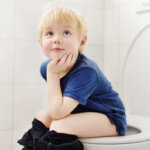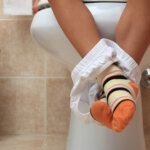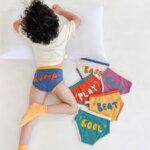By Christina Egan, Centre Director Wellington Childcare.
Most children will be ready to start learning to use the toilet any time between about 20 months and about 3 years. Not all children are ready at the same age.
Try not to feel pressured that your child needs to be toilet trained by a certain age, but rather follow your child’s cues in using the toilet. Each child is different.
The key to successful toileting learning is timing. The more interest your child has in using the toilet, the easier the transition can be. If you find that your child loses interest in using the toilet, don’t worry- that’s completely normal. Stop and try again when they seem more ready. It’s also worth thinking about delaying toilet training if there are some big changes happening such as moving house, a new family member etc.

WHEN TO START?
The following are some examples of signs your child may be ready to start toilet training.
Physically: Your child is developed physically so they can move around independently and can get themselves to the toilet, they have dexterity to pull their underwear up and down with minimum assistance, their nappy is dry for longer periods, they can recognise the feeling that they need to go to the toilet or can control the urge to go – young children will often go off to a quiet/private area to poo.
Cognitively: your child knows what wee and poo are and may talk about them when you’re changing their nappy, they understand the meaning of ‘wet’ and ‘dry’, they can communicate when they needs‘to go’, they understand what you are saying and can follow simple instructions, like ‘Go and get your teddy’, they may become uncomfortable and complain if their nappy is soiled or remove their nappy following a wee.
Socially and emotionally: ‘I can do it’ becomes a regular saying – this shows that your child wants to become more independent, they begin to imitate your behaviour or the behaviour of others, they demonstrate independence – often by saying ‘no’ to requests, they show a desire to please you and other adults – and responds well to praise, they ask to wear underwear.

HOW TO START?
Often families will start toileting training over a long weekend or holiday break so they can have uninterrupted periods of time to work together. Summer can often be a good time to try as children are wearing less clothes to get on and off. When you begin at home, we will continue this practice when they return to the centre. Bring in several spare sets of clothes (not just underwear) each day.
Start by having discussions at home regularly about the toilet, toilet language and about wearing underwear instead of nappies so it can be gradually introduced. Some families’
transition to pull ups from nappies and then on to underwear and some go directly to underwear. Some families choose to use a potty or toilet seat. If you are buying a new toilet seat, potty or underwear, allow the child to be part of the shopping by choosing which one they like the most. This boosts their confidence of feeling important and receiving something new and exciting.
Allow them the time to get used to the toilet seat or potty before they start using it as part of toileting. Introduce it to their home environment- they may choose to use it as a seat or for placing their toys in. This gives them the chance to become more comfortable with a new item. Let them sit on it while wearing their clothes at first to become familiar with how it fits. Once the child begins to use a potty, keep it in a consistent place.
TIPS ALONG THE WAY

Support your child to be as independent as possible by dressing them in clothes that are easy to take on and off quickly. Be consistent; once you make the transition to underwear, don’t go back to nappies as this can confuse the child about what they should be wearing.
Take children to the toilet at regular times. Allow them enough time to try to go- 5 minutes max. Praise them for trying and when they succeed, to keep building their confidence. If they don’t go, calmly tell them that its okay and they will try again soon. Wash your hands!
It takes children some time and practice to understand the urges their body gives them indicating they need to use the toilet. Toileting accidents are a natural part of the process of learning.
Be prepared for when they don’t make it in time, and don’t scold or punish them. Calmly clean up the accident and remain encouraging, talking to them about getting to the toilet when they feel the urge.
When you first start potty training boys, get them to sit on the toilet when they wee. It’s too hard for them to master everything to start with. Standing up and learning to aim can come later, with practice.
NIGHT TIME TRAINING

There is a difference in toileting training during the day and sleeping through the night dry. It’s normal for your child to wet the bed until they are up to five years old .
The child’s body is continuing to develop and they become better at being able to store the wee produced in their bladder overnight or they learn to wake-up with the urge on their own and go to the toilet.
- Ensure going to the toilet before getting into bed is a normal part of their night time routine.
- Continue to use a pull up/nappy at night time until your child has developed a pattern of sleeping through the night dry.
- Do not restrict the amount of fluid your child has in the evening this will not help them to stay dry.
- When your child begins to sleep in underwear, you could begin to use a mattress protector.
- A healthy diet high in fibre and leafy green vegetables is important for a healthy bowel and bladder.
- Avoid too much praise for a dry night as it is out of the child’s control when they can sleep through the night dry.
- Allow your child to walk to the toilet themselves during the night rather than being lifted so they understand the signals and urges telling them to wake up and use the toilet.
AT WELLINGTON CHILDCARE, HOW WE CAN HELP?
In our environment, our toilets are open spaces, freely available, so children will see their friends regularly going in and out of the toilet and being verbally invited and reminded by their teacher to use the toilet. This can often peek their curiosity as children learn by copying others.
If you are comfortable, allow children to watch family members using the toilet at home. Introduce them to the toilet at home and make sure it’s accessible for them which may mean providing a stool/step to reach it.
Make the learning process fun and enjoyable. Encourage your child to be independent and confident.
Most of all, enjoy this milestone in your families life!


